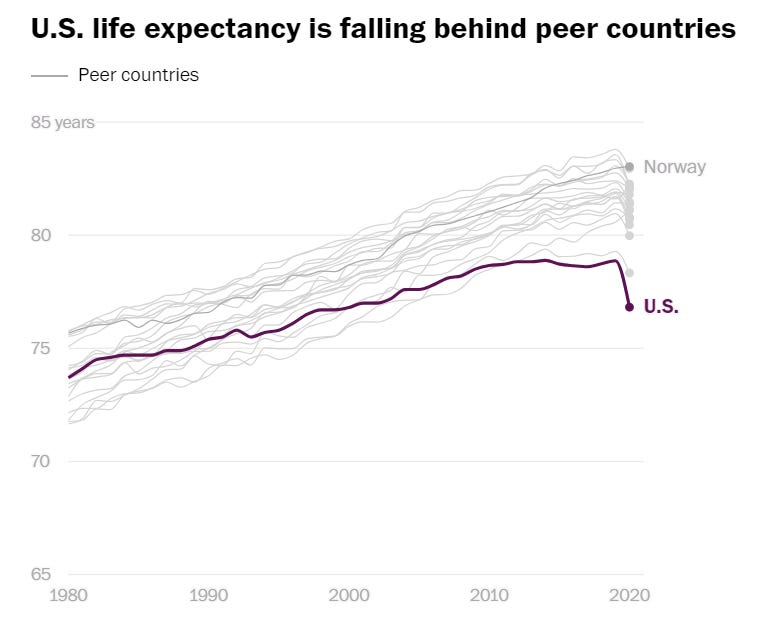109 | Learn from a Malicious Contamination Event at AA+ Certified Food Site
Plus pest control in food businesses, nutrition and life expectancy and a nifty fruit picking gadget
This is The Rotten Apple, an inside view of food integrity for professionals, policy-makers and purveyors. Subscribe for weekly insights, latest news and emerging trends in food safety, food authenticity and sustainable supply chains.
Pest Control in Food Businesses: Training this Thursday
A nasty malicious contamination (food defence) incident (what can we learn?)
Eating badly means dying young, USA life expectancy woes
Food safety news from around the globe
A nifty fruit picking gadget - just for fun
Food fraud news and incidents
🎧 Listen Now (for paying subscribers) 🎧
Hi,🍁 Happy Thanksgiving🍁Canadians!
I was shocked to hear about a food manufacturing worker who put plastic bags, gloves, saliva and ring pulls from cans into the food at his workplace this week. More on that below.
Also this week, bad statistics from the USA, details about this Thursday’s training event and a nifty fruit picking gadget,
As always, I spent last week collecting interesting and important food safety and food fraud news from around the globe for you. It’s hand-curated (by me!) and this week it includes unsafe snails, a rare Staph enterotoxin event and desperate anti-theft measures for olive trees 😮
Karen
P.S. If you love this newsletter and want to support ad-free, not-boring food reporting, please tell your friends and colleagues about it. Your shares really help.
Pest Control in Food Businesses (Free Training)
Topic: Pest Control and IPM (Integrated Pest Management) in Food Businesses
October 12th UTC 08:00 | London 9:00 am, Hong Kong 4:00 pm, Sydney 7:00 pm, Denver 2:00 am | Click to convert to your local timezone |
Link to join 🦟
https://us02web.zoom.us/j/5422067906?pwd=cHVhRk44eFNzVXIwdHlDTnNrSTJmZz09
Meeting ID: 542 206 7906 Passcode: 0X5g4i
All are welcome, and paying subscribers get access to a recording.
What Can We Learn From This Food Defense Incident?
Malicious Contamination - Rare But Nasty
In 2022, a restaurant chain in England began to find foreign objects in bulk dips and sauces they purchased from one supplier. The foreign objects included:
gloves,
paper towels,
metal ring pulls and
plastic bags.

The restaurant chain reported it to their supplier, which investigated the complaints and reviewed CCTV (closed circuit television) footage from inside their factory. They discovered a picker on the late shift – a man who was responsible for collecting and organising ingredients for the next day’s production – was tampering with the ingredients and with containers of hummus and salad dressing.
He also added fish sauce, sesame and chilli sauce to dressings that were not supposed to contain them, creating a risk for allergic consumers. CCTV footage also showed him spitting into a tub of food. His actions created food safety risks and cost his employer “thousands of pounds”.
Once investigators at the food manufacturing site realised they were facing a malicious contamination scenario, they contacted police, who observed the man in CCTV footage in the act of contaminating food. He was arrested, questioned and admitted to intentionally adulterating food. Last week he was sentenced to 33 months in jail.
The food manufacturer recalled (withdrew) all affected batches promptly and was praised by local food safety officials for their swift response.
A failure of the food safety system?
Malicious contamination incidents like this are rare, but can pose serious risks to consumers and to the reputation of food companies.
The detection of intentional contamination can be difficult because food safety systems are designed to prioritise accidental and naturally occurring contamination. For example, in this case, contamination with metal ring pull(s) was not caught by metal detectors because it/they were added after the metal detection step post-production, while the products were in a storage area.
Systems for preventing and detecting malicious contamination events are known as food defence plans. Some people also call them TACCP (Threat Assessment Critical Control Point) plans.
All major food safety management system standards (e.g. BRCGS, SQF, FSSC 22000) contain requirements for food defence plans, including threat assessments to identify threats from both internal and external actors and controls to mitigate risks. CCTV monitoring of food production and storage areas is a common feature of food defence plans.
US food safety regulations include the Intentional Adulteration (IA) Rule which is designed to prevent malicious contamination events that would have a large-scale public health impact.
The food manufacturer in this story, Harvey & Brockless (Worcestershire site), has been certified to BRCGS Food Standard with Grade AA+ since at least 2018, so they would have been operating a compliant food defence plan at the time the contamination occurred.
It seems their food defence plan did not work to prevent the initial contamination. This is probably because the perpetrator was a trusted employee, who had access to sensitive products and areas.
The food defence plan did not prevent the contamination events
The perpetrator may have been suffering from an unanticipated mental health episode, as he was also charged with burglary after breaking into the house of a work colleague and stealing a pink hairbrush.
Mitigating the threat of a trusted employee having a mental health episode is difficult, if not impossible. However, food companies should attempt to mitigate against disgruntled employee actions, by investing in workplace culture improvements.
Was this incident a failure of the BRCGS standard’s food defence requirements?
The food defence plan on this site did not prevent the contamination incident(s). It did, however, succeed in limiting the scale of the contamination and, more importantly, it prevented consumers from being harmed.
Consumers were protected because…
the food company responded quickly to complaints from the customer;
the food company had CCTV in some sensitive areas of the facility;
timely access to recordings from CCTVs was possible (that is, recordings were retained and accessible);
the food company acted swiftly to recall affected batches from commerce and quarantine affected batches that had not been despatched;
police were contacted promptly, so that robust evidence could be collected for prosecution and ensuring that the perpetrator could be prevented from returning to work.
Since the incident, the food company has invested in more CCTV cameras to cover more parts of their facility.
Other actions the food company could consider relate to employee satisfaction, employee mental health and workplace culture.
Takeaways
Disgruntled employees and employees with mental health issues can act to maliciously contaminate food. Because such actions are difficult to predict and control, food defence plans may not always be successful at preventing contamination.
However, a properly functioning food safety management system can mitigate harm if malicious contamination occurs by allowing for swift responses, successful investigations, using, for example, CCTV footage and prompt and complete recalls.
In short: 🍏 A malicious contamination event (food defence incident) occurred at a site with AA+ grade BRCGS certification 🍏 The food site acted quickly when customer(s) notified them of contamination 🍏 Affected food was promptly withdrawn and/or quarantined 🍏 The perpetrator was caught and successfully prosecuted 🍏 Contaminated food did not reach consumers 🍏
https://www.harveyandbrockless.co.uk/dbfile.axd?name=EveshamBRC2023.pdf
https://directory.brcgs.com/site/8516549
That’s interesting: US life expectancy is decreasing with poor nutrition to blame
If life expectancy is a benchmark of a nation’s success, the USA is in big trouble. The life expectancy of the average American has been falling since 2014, even before covid hit.
In 2020, life expectancy in the US had fallen 7 years behind Switzerland and Norway, at 77 years, compared to 84 and 83 years respectively.
The biggest causes of this trend? Cardiovascular diseases and cancer linked to poor dietary and other lifestyle choices.

🍏 Read more: Life expectancy in U.S. is falling amid surges in chronic illness - Washington Post 🍏
Food Safety News and Resources
9 October | Food Safety News and Free Resources | Intentional malicious adulteration incident (UK) | Undeclared allergen recalls (Europe) | Unsafe snails seized (Portugal) | Staphylococcus enterotoxin in cheese (Switzerland, Germany) | New Guidance on Equipment Management from FSSC (Global) |
A Nifty Fruit Picking Gadget – Just For Fun
This safe-for-work video brightened my day.
What you missed in last week’s email
An introduction to food fraud (video)
Targetted versus non-targetted tests for food fraud detection
Fascinating food fraud insights from food control officers
Food Fraud News and Recent Incidents
Below for paying subscribers: Food fraud news, emerging issues, research papers and incident reports
📌 Food Fraud News 📌
Increasing risks from cargo thefts
The latest figures for cargo thefts saw a 57% increase year-on-year. Food and beverages and electronics were the most frequently targeted products. Most of the increase was due to shipment misdirection attacks, which occur when





